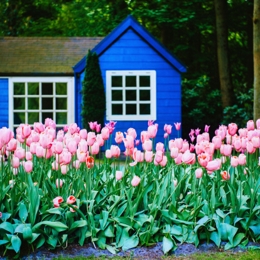Tulips are one of the most beautiful flowers, coming third in popularity after roses and chrysanthemums. Here are some tips for taking care of these breathtaking flowers.

When we think about tulips, Holland, known as the 'land of tulips', comes to mind immediately. And it is true enough, the Netherlands exports thousands of bulbs of tulips each year all over the world. However, according to some accounts, the name has its origins in the Persian word for turban, which is 'toliban', while others say that it is actually a Turkish word, 'tulbend', which also means turban, that the name has been derived from. Why turban? Well, when the flower is inverted, it is said to look like a turban.
Belonging to the lily family, the tulip grows wild in its native territory, which is vast, ranging from China to Siberia through Asia Minor. As far as popularity goes, the beauteous tulip comes third, after the rose and chrysanthemum. Since it is shipped while it is a bud from Holland, tulips come across a long distance indeed, and hence require special care. Given below are a few tulip care tips.
- Even though the tulip is regarded as a perennial, it is, however, best to consider them to be annuals, since their blooming cycle and care lasts practically all year round.
- The best time to plant tulips is in fall. In some areas it can be planted in the middle of September right up to early October, whereas in other areas, you can wait up to November, December, or even January, before planting them. It is really dependent on when the ground begins freezing.
- Tulips need to be planted in sandy soil, since this is the kind of soil that has the best drainage, which is an important factor. In case you grow them in planters, ensure that there is adequate drainage. If the drainage is not proper it will result in the bulbs rotting. If the soil in the area you live in is not sandy, then sand can be added to the soil. In addition, ensure adding some compost as well. The key is to have soil that is well drained, but also able to retain some amount of moisture.
- Since tulips come in various sizes, there is no particular depth that can be recommended for planting them. However, in order to get an approximate idea about the depth at which the bulbs should be planted, measure the size, then multiply that with three, and that is the depth you should plant the bulb in.
- Tulips thrive in a fair amount of sun. Experts recommend that they be planted in partially shaded areas. They require plenty of water. If there is enough rainfall in your area, then that is enough. However, in regions that are warm throughout the year, you need to ensure that your plants are watered at least once in a week.
- Tulips need to be fertilized twice in a year, and the best time to do so is in the early part of spring, before they begin blooming again. A tablespoon of any granular fertilizer should be added onto the soil, around each plant.
- Although they are generally hardy plants, and ward off most diseases that beset flowering plants, but they do fall prey to 'tulip fire', which results in the stems becoming deformed and stunted. If this should occur, you will need to remove all the plants completely and start over again.
Tulips, which come in a variety of lovely colors like white, yellow, red, pink, and purple, make lovely ornamental flowers that can be kept in vases, where they can generally last for as much as a week. Make sure to add some sugar to the water; this will extend the life of your tulip bouquet.






 When we think about tulips, Holland, known as the 'land of tulips', comes to mind immediately. And it is true enough, the Netherlands exports thousands of bulbs of tulips each year all over the world. However, according to some accounts, the name has its origins in the Persian word for turban, which is 'toliban', while others say that it is actually a Turkish word, 'tulbend', which also means turban, that the name has been derived from. Why turban? Well, when the flower is inverted, it is said to look like a turban.
When we think about tulips, Holland, known as the 'land of tulips', comes to mind immediately. And it is true enough, the Netherlands exports thousands of bulbs of tulips each year all over the world. However, according to some accounts, the name has its origins in the Persian word for turban, which is 'toliban', while others say that it is actually a Turkish word, 'tulbend', which also means turban, that the name has been derived from. Why turban? Well, when the flower is inverted, it is said to look like a turban.